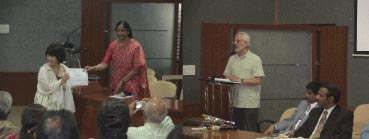| Home | Theme & Guest Speakers | Introduction | Schedule | Travel Information | Greeting Message |
| Registration Fees | Call for Papers/Posters | Art Activity | About The City | Japanese |
Report : 11th 12th 13th 14th | News Clippings | Message From Former President of India
| Registration Fees | Call for Papers/Posters | Art Activity | About The City | Japanese |
Report : 11th 12th 13th 14th | News Clippings | Message From Former President of India
Valedictory Comments
Edward F. Ansello, Ph.D.
14 March 09
I am pleased to have the opportunity to offer comments about this inaugural conference now concluding. First, I, too, wish to add my appreciation for the leadership and vision so well demonstrated by Andhra University. I am honored to have been a part of this auspicious beginning.Edward F. Ansello, Ph.D.
14 March 09
I would like to speak briefly on four matters: 1) a reiteration of the vision of the DaVinci Kigatsuku project; 2) observations about the papers given during this conference; 3) a perspective on our meeting with the Vice-Chancellor, Professor Beela Satyanarayana; and 4) next steps for India.

1. The Vision of the DaVinci Kigatsuku Project.
The project's name reflects the incredible insights of the great Renaissance artist and inventor, Leonardo DaVinci, who saw with "SOUL" (See-Observe-Understand-Learn) in ways that others did not, and the Japanese word that suggests doing the right thing without being told to do so. Colleagues from several nations have been working together under the inspiration of Dr. Ryo Takahashi and Nippon Carefit Service Association to do the right thing in gerontological education; for the world is growing older, and a longer life should be seen not as a problem but as an opportunity. The DaVinci Kigatsuku project asks three questions: How can we develop a philosophy that recognizes the worth of a person with age or with a disability? How shall we modify our current gerontology curriculum to reflect this philosophy and, thereby, recognize individuation in the life course and the importance of both the internal and the external in the lives of humans as they grow older? How can we help make this gerontology curriculum relevant to the whole life course and relevant globally?

2. Observations about Conference Papers.
Presentations by colleagues at this meeting were first rate. They were thoughtful, well delivered, and, at times, inspirational. I was personally impressed that so many seemed to relate to what I call the "curriculum palette." In Okinawa in 2007 we acknowledged publicly that a curriculum about gerontology should include more than just an expanded core of subject matter. Adding business, technology, the humanities and the arts augments the subject matter of the core curriculum but may not be equally relevant in every cultural context. Adding an interior focus to the study of human life and human aging, however, complements and helps to further the approaches to understanding. Meditation, yoga, introspection, Eastern and Western spirituality and more should be part of the array, part of what we are calling the cafeteria curriculum or the curriculum palette. With such a curriculum palette at hand, gerontological educators anywhere might select carefully the "colors" most relevant to the cultural canvas on which they work. At this Andhra conference I heard presentations about the role of yoga, music, spirituality, and various forms of medicine in gerontology; about a life span approach for business and information technology; about interdisciplinary approaches to caregiving; and so much more that was relevant to developing a curriculum palette for India.
3. Our Meeting with the Vice-Chancellor.
The Vice-Chancellor "gets it." By this I mean that he has insight and a vision for how Andhra University and this DaVinci Kigatsuku project can work together to establish gerontology at the university. For our meeting he convened knowledgeable faculty members, people with talent and valuable skills. The Vice-Chancellor understands the importance of gerontology for India, with its growing aging population. He sees the relevance of gerontology to so many disciplines within the university and how, together, they can contribute to a fuller understanding of the life course. Importantly, he appreciates the opportunity that Andhra University now has to play a leadership role not only across all of India but also across Southeast Asia through gerontological distance education.

4. The Next Steps for India.
I see several positive actions ahead. Allow me to share four. First, my colleagues and I have great faith in the leadership of Professor M.V.R. Raju, Head of the Department of Psychology at Andhra University. We believe that his initiative will advance the gerontology program at this university and will help establish Andhra in a pivotal position for all of India. Second, the project team (Takahashi, Janicki, Lucchino, Ansello) will work to submit session proposals to the Gerontological Society of America (GSA) and to the Association for Gerontology in Higher Education (AGHE) so that we might share information about this undertaking here in India with colleagues in America and across the world at the GSA annual meeting in November 2009 and the AGHE annual meeting in February 2010. Third, my American colleagues and I will explore the role of gerontological distance education as a means of reaching out from Andhra to all of India and to the developing nations in the region. Dr. Ron Lucchino has a strong background in distance education and my own university, Virginia Commonwealth University, is well know for its work in this matter. We hope that we will be able to partner with our colleagues here in India. Fourth, the project hopes to establish collaboration with the World Health Organization (WHO) to reach institutions in developing countries with our message of the curriculum palette in gerontology and to introduce a focus on gerontology within the WHO itself. Both Drs. Ryo Takahashi and Matthew Janicki have histories of successful interactions with WHO.
I look forward to seeing you, my friends, again as we work together in this worthy project. Thank you.